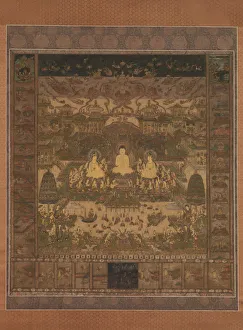Nanbokuchō Period Collection
The Nanbokuchō period, which spanned from the late 14th century to the early 15th century in Japan, was a time of great artistic and cultural development
All Professionally Made to Order for Quick Shipping
The Nanbokuchō period, which spanned from the late 14th century to the early 15th century in Japan, was a time of great artistic and cultural development. During this period, many remarkable works of art were created by unknown artists, showcasing their immense talent and skill. One such masterpiece is the Taima Mandala, believed to have been crafted in the late 14th century. This intricate mandala depicts various Buddhist deities and celestial beings in vibrant colors and meticulous detail. It serves as a visual representation of Buddhist teachings and provides a spiritual experience for those who gaze upon it. Another notable artwork from this era is the Welcoming Descent of Amida and Bodhisattvas. Created by an anonymous artist during the late 14th century, this piece portrays Amida Buddha descending from heaven accompanied by bodhisattvas. The delicate brushwork and serene expressions on their faces evoke a sense of tranquility and enlightenment. The Mandala of Wakamiya of Kasuga Shrine is yet another fascinating creation from the early 14th century. This mandala showcases various gods worshipped at Kasuga Shrine through intricate patterns and symbols. Its purpose was to invoke blessings for prosperity, protection, and good fortune. In addition to religious artworks, secular pieces also flourished during this period. Plum Blossoms is one such example; its exact creator remains unknown but dates back to between 1336-92. This painting captures the beauty of plum blossoms with delicate brushstrokes that bring them to life on paper. The it also saw the rise of temple complexes adorned with stunning sculptures like Fudo Myoo created by Ryushu Shutaku or other unknown artists during the 14th century. These sculptures depict powerful deities known as Wisdom Kings who protect Buddhism's teachings fiercely. Furthermore, depictions like Attendant of Fudo Myoo showcase skilled craftsmanship and attention to detail.


















